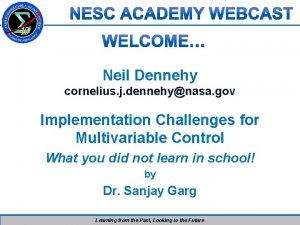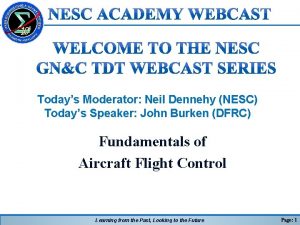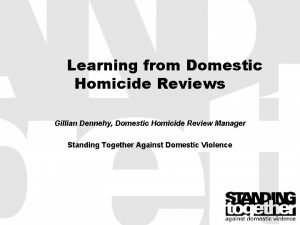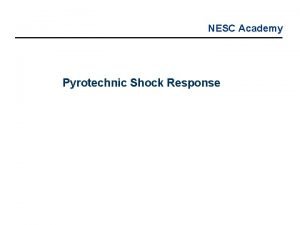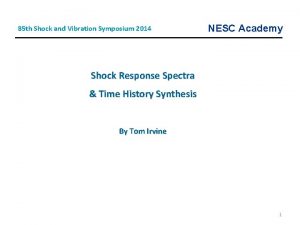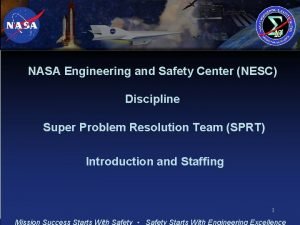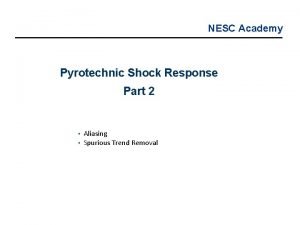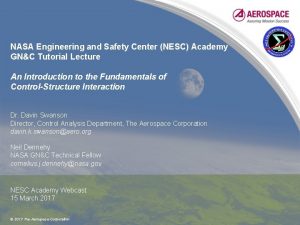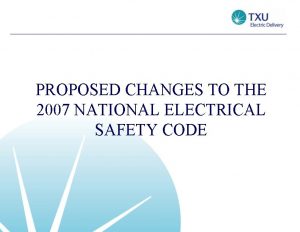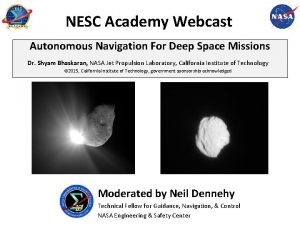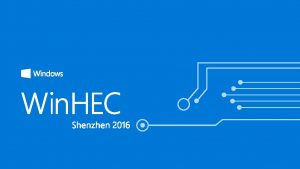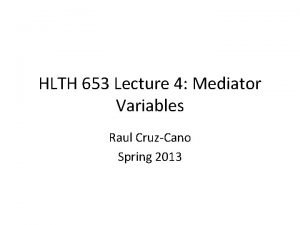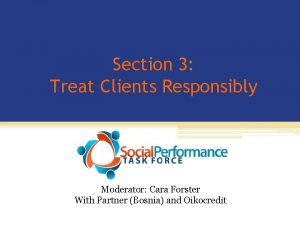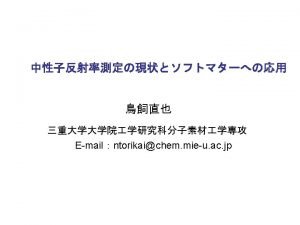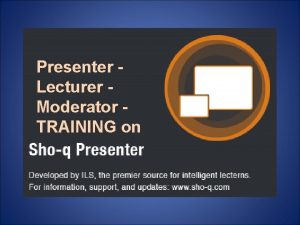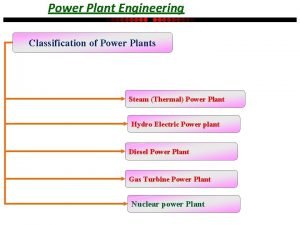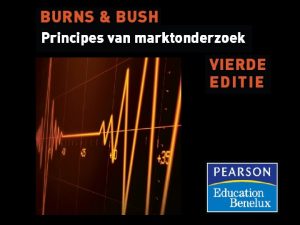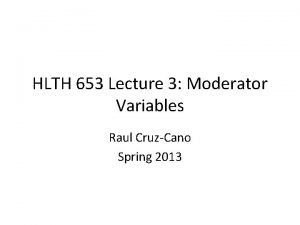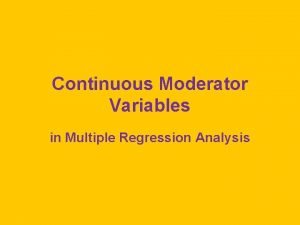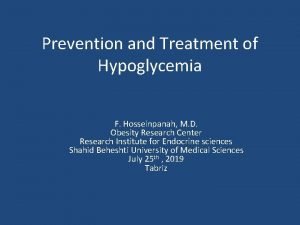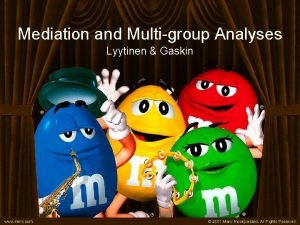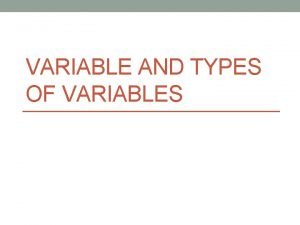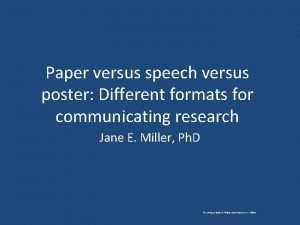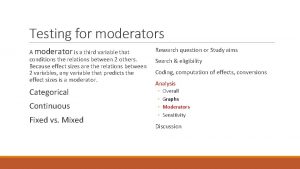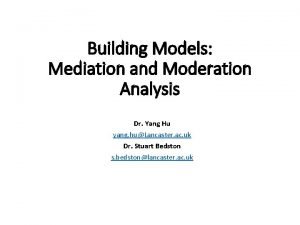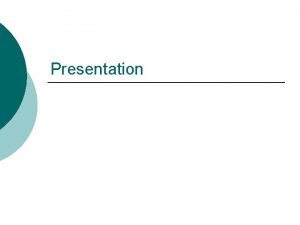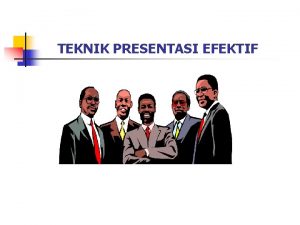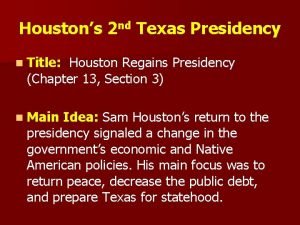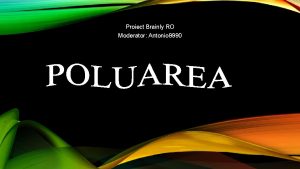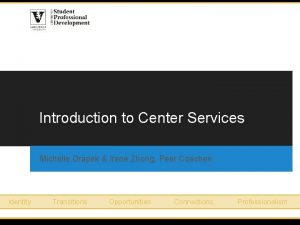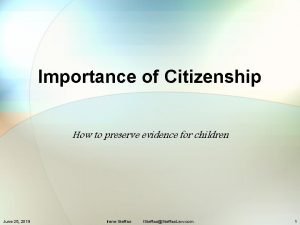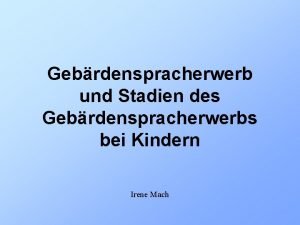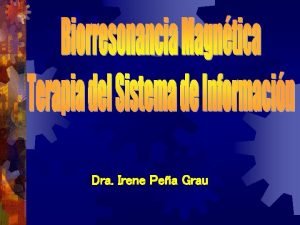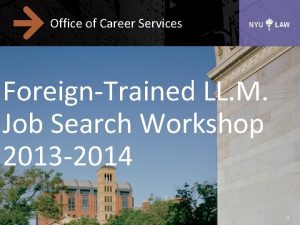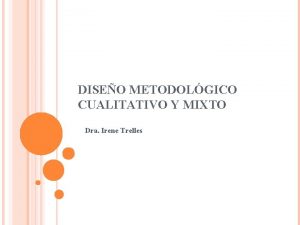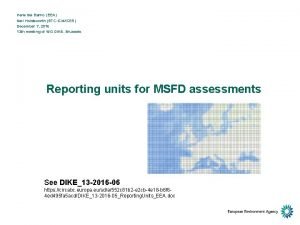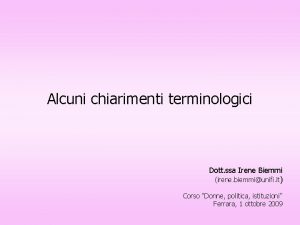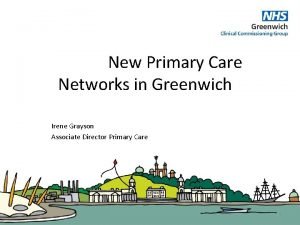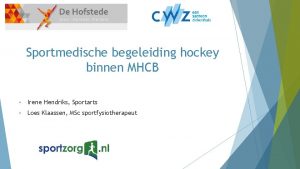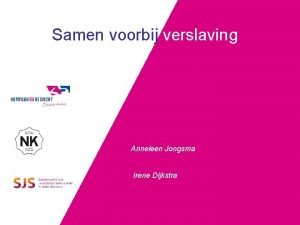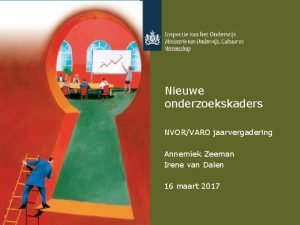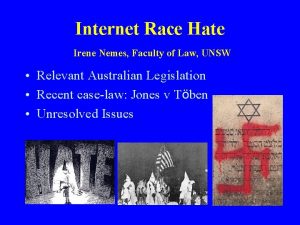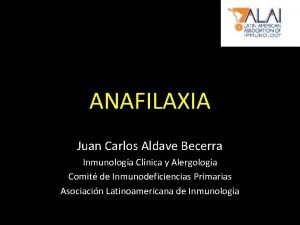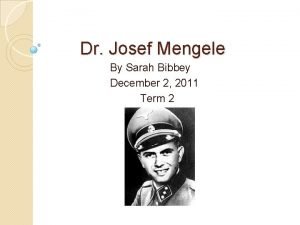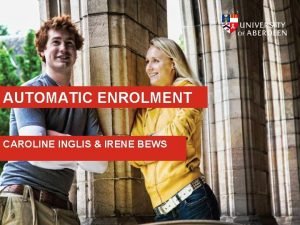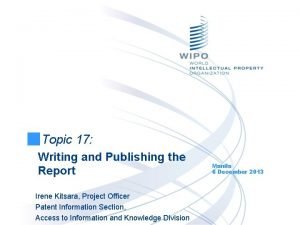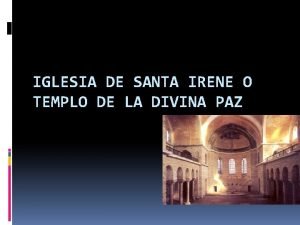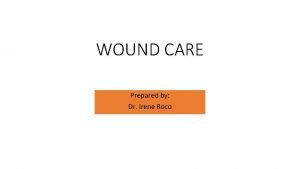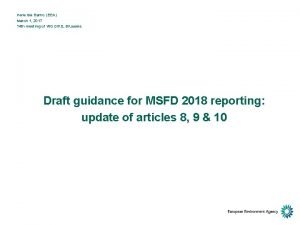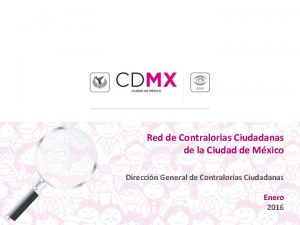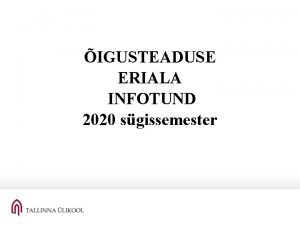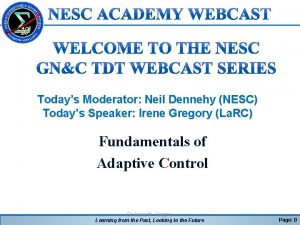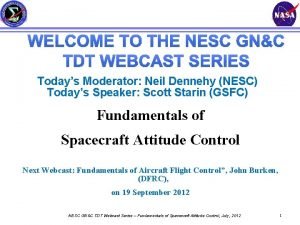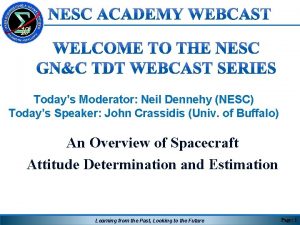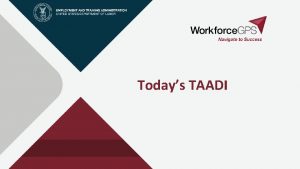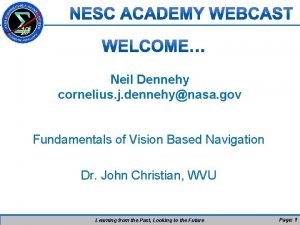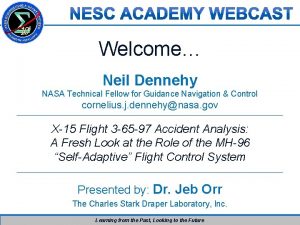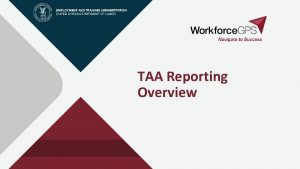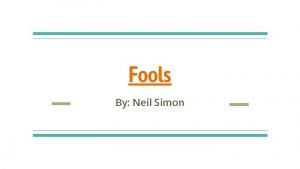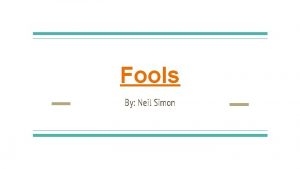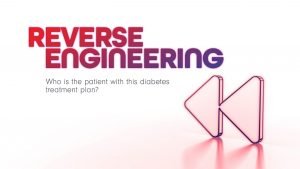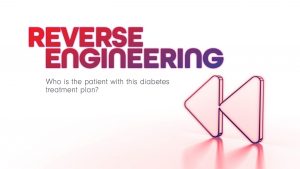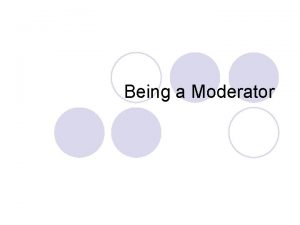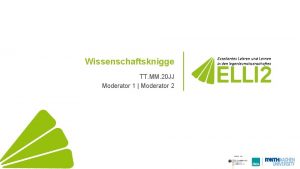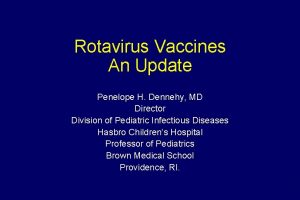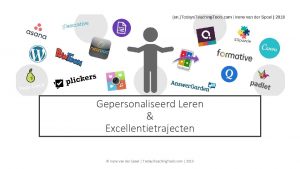Todays Moderator Neil Dennehy NESC Todays Speaker Irene
































































- Slides: 64

Today’s Moderator: Neil Dennehy (NESC) Today’s Speaker: Irene Gregory (La. RC) Fundamentals of Adaptive Control Dr. Irene M. Gregory Learning from the Past, Looking to the Future Page: 0

Dr. Irene M. Gregory Learning from the Past, Looking to the Future Page: 1

Fundamentals of Adaptive Control Flight Control Perspective Dr. Irene M. Gregory Dynamic Systems and Control NASA Langley Research Center NESC GNC Webcast 28 November 2012

Outline • Why adaptive control? • Brief history of adaptive control in flight • What is adaptive control? – Working definition • Recent methods in flight • Advantages/Limitations • Open problems and future directions Dr. Irene M. Gregory 3

Why Adaptive Control? • Linear control methods often unable to provide good stability margins and desired tracking performance in the presence of highly non-linear airframe characteristics – Leads to high gain feedback to dominate nonlinearity – Requires extensive gain scheduling and accurate aerodynamic models • Benefits of Adaptive Control – provides consistent performance in the presence of modeling uncertainties, large parameter variations and unknowns – does not need accurate aerodynamic model • Direct Adaptive Control – provides incremental command to cancel / dominate uncertainties in aerodynamic modeling » nonlinear moments – “freezes” if desired tracking performance is achieved – does not rely on system (plant) ID Nonlinear Solution to a Nonlinear Problem Dr. Irene M. Gregory 4

Brief History of Adaptive Flight Control Dr. Irene M. Gregory 5

Motivation for Adaptive Control • Early 1950 s – design of autopilots operating at a wide range of altitudes and speeds • Fixed gain controller did not suffice for all conditions • Gain scheduling for various conditions • Poor sensors for efficient gain scheduling • Several schemes for self-adjustment of controller parameters • Sensitivity rule, MIT rule • 1958, R. Kalman, self-tuning controller • Optimal LQR with explicit identification of parameters • 1950 -1960 – flight tests X-15 (NASA, USAF, US Navy) • Bridge the gap between manned flight in the atmosphere and space flight • Mach 4 - 6, at altitudes above 30, 500 meters (100, 000 feet) • 199 flights beginning June 8, 1959 and ending October 24, 1968 • Nov. 15, 1967, X-15 A-3 Dr. Irene M. Gregory 6

First Flight Test in 1967 (“Brave era” a la Astrom) § The crash of the X-15 A-3 (November 15, 1967) Crash due to stable, albeit non-robust adaptive controller! Dr. Irene M. Gregory Crash site of the X-15 A-3 7

Adaptive Control in Transition F-8 (NASA) 60 s X-15 (NASA/USAF/ US Navy) § Fast adaptation § Single design AFCS NPS Flight Test Program Sig RASCAL 90 IFCS (NASA/Boeing) F-15 ACTIVE 95 RESTORE (AFRL-VA/Boeing) X-36 00 GTM T 2 (NASA) 05 Adaptive Control for Munitions (AFRL-MN/GST/Boeing) MK-84 10 NASA La. RC MK-82 L-JDAM in production J-UCAS (DARPA/USAF/US Navy) Boeing X-45 A & X-45 C MK-84 JDAM • Gen I: flown 1999, 2003 • Gen II: 2002 – 2006 ü flight test 4 th Q 2005 • Gen III: 2006 in production § Slow adaptation § “Expensive” gain-scheduled AFCS Dr. Irene M. Gregory evaluated in flight sim environment Source: Kevin Wise, Boeing (adapted) 8

What is Adaptive Control? Dr. Irene M. Gregory 9

What is Adaptive Control? • Pragmatic definition: An adaptive controller is a controller with adjustable parameters and a mechanism of adjusting the parameters. (Astrom) • An adaptive control system can be thought of as having two loops. – One loop is a normal feedback loop with the process and the controller. – The other loop is the parameter adjustment loop. » The variation in uncertainty that an adaptive system can handle depends directly on the speed of the parameter adjustment loop Dr. Irene M. Gregory 10

Stability, Performance and Robustness Absolute Stability versus Relative Stability Linear Systems Theory • Absolute stability is deduced from eigenvalues • Relative stability is analyzed via Nyquist criteria: gain and phase margins • Performance of input/output signals analyzed simultaneously Nonlinear Systems Theory • Lack of availability of equivalent tools • Absolute stability analyzed via Lyapunov’s direct method • Relative stability resolved in Monte-Carlo type analysis • No correlation between the time-histories of input/output signals Dr. Irene M. Gregory 11

Direct & Indirect Methods of Adaptive Control Direct Method: • • Estimate the controller parameters The stable error dynamics and adaptive laws are derived using the structure of the control signal Indirect Method: • • Estimate the system parameters • The control signal is synthesized using the estimated system parameters • Focus on model based adaptive systems The stable error dynamics and adaptive laws are derived independent of the control signal – Specify desired performance for the plant dynamics Dr. Irene M. Gregory 12

Implementation Architectures Reference system Direct MRAC Indirect MRAC State Predictor Dr. Irene M. Gregory 13

Recent Methods in Flight Model Reference Adaptive Control MRAC Dr. Irene M. Gregory 14

Model-Reference Adaptive Control reference model controller plant adaptation law • Plant has a known structure but the parameters are unknown • Reference model specifies the ideal (desired) response ym to the external command r • Controller is parameterized and provides tracking • Adaptation is used to adjust parameters in the control law Dr. Irene M. Gregory 15

MRAC: 1 st Order Nonlinear System • System Dynamics: – are constant unknown parameters – uncertain nonlinear function: » vector of constant unknown parameters: » regressor vector of known RBF-s: • Stable Reference Model: • Control Goal – find u such that: Dr. Irene M. Gregory 16

MRAC: 1 st Order Nonlinear System (cont’d) • Adaptive Control Solution: – (N + 2) parameters to estimate on-line: • Closed-Loop System: • Desired Dynamics: • Matching Conditions Assumption – there exist ideal gains such that: – Note: knowledge of the ideal gains is not required, only their existence is needed, (in this case, ideal gains always exist) • Tracking error: Dr. Irene M. Gregory 17

MRAC: 1 st Order Nonlinear System (cont’d) • Adaptive Law – makes time-derivative of a Lyapunov function decrease along the error dynamics trajectories • Time-derivative of the Lyapunov function becomes semi-negative definite, (that is closed-loop system energy dissipates), yields stable dynamics • Barbalat’s Lemma ensures that Dr. Irene M. Gregory is bounded 18

MRAC: 1 st Order Nonlinear System Reference Model Plant • Adaptive gains: • On-line function estimation: • Adaptive Control Solution: Dr. Irene M. Gregory 19

Robustness: Parameter Drift & Unmodeled Dynamics • When external input r(t) is persistently exciting the system, both simulation and analysis indicate that MRAC systems are robust w. r. t non-parametric uncertainties (unmodeled dynamics) • When external input r(t) IS NOT persistently exciting even small uncertainties may lead to severe problems – estimated parameters drift slowly as time goes on, and suddenly diverge sharply – reference input contains insufficient parameter information – adaptation has difficulty distinguishing parameter information from noise • Inability to properly model the true plant coupled with significant excitation in the frequency band where that ineffective modeling occurs may cause instability. • In Summary – Parameter drift occurs when signals are not persistently exciting – Mainly caused by measurement noise and disturbances; unmodeled dynamics – Does not effect tracking accuracy until the instability occurs • Leads to sudden failure Dr. Irene M. Gregory 20

MRAC Key Implementation Components • Radial Basis Functions, (RBF-s) – on-line approximation of system uncertainties – nonlinear integrators in the closed-loop • e & s – Modification – robustification of MRAC (no PE) – adds damping to adaptive dynamics – keeps adaptive parameters bounded (similar to Projection Operator) • m – Modification – explicitly accounts for actuator position limits – keeps adaptive dynamics stable by changing external command in the presence of actuator constraints • Dead – Zone Modification – dealing with noise – stops adaptation when tracking error is small – prevents learning from noise – can be used to not let adaptive augmentation change nominal closedloop tracking performance • Projection Operator, (smooth version) – integrator anti-windup protection – keeps all adaptive parameters within pre-specified bounds Dr. Irene M. Gregory 21

Flight Control State-of-the-Art – Brief Summary • Model Reference Adaptive Control (MRAC) Augmentation – Flight proven on X-36 RESTORE, MK-82 LJDAM, MK-82 JDAM (production), etc. • Theoretically justifiable and verifiable characteristics – – State feedback - satisfactory for standard flight control Guarantees bounded tracking Bounds adaptive parameters (using modifications) Provides anti-windup protection during control saturation (using m-mod) • Guarantee stability, but not transient performance – Transient performance achieved by tuning control parameters – Schedule adaptive gains with flight condition – Requires intensive Monte Carlo runs, i. e. no a priori guarantees Dr. Irene M. Gregory 22

Transient Performance of MRAC • Parameters of interest in transient performance – – • The transient of MRAC depends on – – • overshoot settling time control signal frequencies etc. Adaptive gain and other tuning parameters Knowledge of the true unknown parameter Initial values of system states Reference Input Highly nonlinear relationship between these parameters is introduced via adaptive law Linear systems – System response and control signal are linear (scaled and sum) with respect to reference input and initial conditions – Performance can be predicted using unit step response • MRAC is highly nonlinear process – The transient for a new condition can be totally different and unpredictable Dr. Irene M. Gregory 23

Lessons Learned From Previous Programs • Lessons Learned*: ª Limited to slowly-varying uncertainties, lack of transient characterization ª Fast adaptation leads to high-frequency oscillations in control signal, reduces the tolerance to time-delay in input/output channels ª Determination of the “best rate of adaptation” heavily relies on Monte-Carlo runs Challenge: How to achieve FAST adaptation with NO OSCILLATIONS and with GUARANTEED Time Delay Margins *V. Patel, C. Cao, N. Hovakimyan, K. Wise, E. Lavretsky, “L 1 Adaptive Controller for Tailless Unstable Aircraft in the Presence of Unknown Actuator Failures”, Proc. of AIAA Guidance, Navigation and Control Conference, Hilton Head Island, SC, 2007. Dr. Irene M. In Gregory 24

Recent Methods in Flight L 1 Adaptive Control Dr. Irene M. Gregory 25

Implementation Architectures Reference system Direct MRAC cannot be low-pass filtered directly Indirect MRAC Enables insertion of a low-pass filter Dr. Irene M. Gregory No reference system with filtering 26

Notional L 1 Control Law State Predictor Adaptation Law Performance vs. Robustness Tradeoff Ø L 1 control law consists of a fast estimation scheme and a control law Ø Fast estimation scheme includes • state predictor – generates a prediction of system state • adaptation law - used to generate estimates of plant uncertainties Ø Error e , between actual system state and prediction , drives the adaptation process. Ø Adaptation law updates the estimates of the plant uncertainties at a high adaptation rate. Ø Based on the uncertainty estimates, control law generates control surface deflection commands u as the output of low pass filters Dr. Irene M. Gregory 27

L 1 Adaptive Control § System dynamics: § State predictor: § Controller: § Adaptive law: Dr. Irene M. Gregory 28

Separation Between Adaptation & Robustness Key feature of L 1 adaptive control: Feasibility of the control objective • System: • Nominal controller in MRAC: • Desired Reference System: • Nominal controller in L 1: • Achievable reference system: High-pass filter attenuates low freq. uncertainty Desired system behavior w/o uncertainty Dr. Irene M. Gregory Ideal system response to IC 29

Main Features of L 1 Adaptive Control • Separation (decoupling) between adaptation & robustness • Performance limitations consistent with hardware limitations • Guaranteed fast adaptation • Guaranteed transient response for system’s input and output • NOT achieved via persistence of excitation or gain-scheduling of adaptive gains • Guaranteed (bounded away from zero) time-delay margin • Uniform scaled transient response dependent on changes in initial conditions, unknown parameters, and reference input • Suitable for development of theoretically justified Verification & Validation tools for feedback systems Dr. Irene M. Gregory 30

Benefits of Fast Adaptation MRAC adaptive control basis function, constant parameters locally uniformly bounded error adaptive control signal L 1 adaptive control arbitrarily fast time-varying parameter and disturbance adaptive control signal Ø ignores the explicit dependence upon time Ø choice of basis functions based on intuition Ø significant tuning Ø local results Ø no selection of basis function needed Ø systematic tuning Ø semi global results Ø guaranteed transient Ø transient needs to be tuned Dr. Irene M. Gregory 31

Phase Margin: MRAC and L 1 for a PI Controller MRAC L 1 § Loop transfer functions: § Phase margin: Dr. Irene M. Gregory § Phase margin: 32

Time-Delay Margin: MRAC and L 1 for a PI Controller MRAC L 1 § Open loop transfer functions in the presence of time-delay: § Time-delay margin : § Application of nonlinear L 1 theory: Dr. Irene M. Gregory 33

Recent Methods in Flight L 1 Adaptive Control Supporting Extended Flight Envelope Modeling through stall and departure Flight Test Example Dr. Irene M. Gregory 34

MIMO Nonlinear System with Cross-Coupling • Consider nonlinear system dynamics • Can be expressed as the following system: Matched uncertainty Actuator dynamics Unmatched uncertainty Unmodeled dynamics • Control objective: – Design an adaptive state feedback control law u(t) to ensure that the system output response y(t) tracks the output response ym(t) of the desired system Dr. Irene M. Gregory 35

Post-Stall Flight Testing Conducted testing to obtain parameter identification data and evaluate control law performance in an envelope relevant to LOC conditions. LOC Accident Data Flight Validation Dr. Irene M. Gregory Air. STAR Departure Maneuvers: Flights 54, 55, 58 Training Simulation Database 36

Air. STAR Flight Testing in Upset Conditions May 2011 Deployment, Ft. Pickett, VA Demonstrated real-time stability and control characterization during approach to stall, and through departure and recovery. Single maneuver coverage Applied L 1 adaptive control to lengthen time on condition with stabilization that allowed slow transition through stall boundary and improved stall/departure recovery Dr. Irene M. Gregory 37

Adaptive Flight Control: Open Problems • Reference model design • Optimization of filtering structure for L 1 adaptive control • Adaptive structural mode suppression – Output feedback with a priori specified transient performance • Gain and time delay margins for adaptive systems – generalization to include nonlinear systems via output feedback – Switching reference systems Dr. Irene M. Gregory 38

ANY QUESTIONS? Learning from the Past, Looking to the Future Page: 39

Upcoming NESC GN&C TDT Webcast “Fundamentals of Spacecraft Attitude Determination”, John Crassidis (Univ. of Buffalo), on 16 January 2013 Learning from the Past, Looking to the Future 20 June 2012 Update

Backup Slides Dr. Irene M. Gregory 41

Instability/Bursting due to Unmodeled Dynamics Unmodeled dynamics Rohr’s Example plant dynamics System output Instability Parameters Bursting Dr. Irene M. Gregory 42

Rohrs’ Example: Unmodeled dynamics System with unmodeled dynamics: Nominal values of plant parameters: plant dynamics Unmodeled dynamics Reference system dynamics: Control signal: Adaptive laws from Rohrs’ simulations: Dr. Irene M. Gregory 43

Difference in Feedforward TFs Pref(s) r(t) + + + y(s) u Pum(s) MRAC P(s) MRAC cannot alter the phase in the feedforward loop + + The phase shift in the feedforward loop is the mechanism that prevents instability r(t) kg + + Ppr (s) + y(s) u - Pum(s) P(s) L 1 Dr. Irene M. Gregory 44

What do we need to know? • Boundaries of uncertainties sets the filter bandwidth • CPU (hardware sets adaptive gain What do we get? • Provides fast adaptation to rapid variation of uncertainties – Arbitrarily fast time-varying parameters and disturbances • Uniform closed-loop tracking performance across flight envelope Dr. Irene M. Gregory 45

nth Order Systems with Matched Uncertainties • System Dynamics: – are constant unknown matrices – is known constant matrix, and – is known, assuming • Uncertainty Approximation: – matrix of constant unknown parameters: – vector of N fixed RBF-s: – function approximation tolerance: Dr. Irene M. Gregory 46

nth Order Systems with Matched Uncertainties • Stable Reference Model: • Control Goal – bounded tracking, (UUB): • MRAC Design Process – choose N fixed RBF functions » can be performed off-line in order to incorporate any prior knowledge about the uncertainty – design MRAC and evaluate closed-loop system performance – repeat previous two steps, if required Dr. Irene 47 M. Gregory

Control Solution: Adaptive Augmentation • Nominal Control: not required • Adaptive Control: • Total Control: – asymptotic tracking Dr. Irene M. Gregory 48

MRAC Block-Diagram x Reference Input, r(t) • • • Reference Model provides desired response Nominal Baseline Controller may be incorporated Solution: Total Adaptive Control or Adaptive Augmentation of a Baseline Controller Dr. Irene 49 M. Gregory

nth Order Systems with Matched Uncertainties • System Dynamics: are constant unknown – matrices – is known constant matrix, and – is known • Stable Reference Model: – defines stable nominal closed-loop dynamics achievable under baseline control – forms desired dynamics for adaptive augmentation with uncertainties • Control Goal – bounded tracking, (UUB): Dr. Irene M. Gregory 50

MRAC Design Algorithm Summary • Approximation of uncertainty: – matrix of constant unknown parameters: – vector of N fixed RBF-s: – function approximation tolerance: • Control law: Dr. Irene M. Gregory 51

Introducing Projection Operator • Requires no damping terms • Designed to keep NN weights within pre-specified bounds • Maintains negative values of the Lyapunov function time-derivative outside of a compact subset • Contributes to providing closed-loop SISL • Equivalent to a nonlinear integrator anti-windup protection Dr. Irene 52 M. Gregory

Projection Operator • Function defines prespecified parameter domain boundary • Example: • specifies boundary tolerance Dr. Irene 53 M. Gregory

Projection Operator, (continued) • Definition: • Depends on • Does not alter y if is within the pre- specified bounds: • Gradient: • In the operator subtracts gradient vector (normal to the boundary) from y – get a smooth transition from y for a tangent vector field for • Important Property – yields closed-loop SISL Dr. Irene 54 M. Gregory to

Adaptation with Parameter Projection • Modified adaptive laws: • Projection Operator, its bounds and tolerances are defined column-wise • Lyapunov function time-derivative is negative outside of a compact domain – implies system stability and boundedness of tracking error • Adaptive parameters stay within the pre-specified bounds Dr. Irene 55 M. Gregory

Direct Method of Adaptive Control § System dynamics: § Ideal controller: § Reference System: § Adaptive controller: § Error dynamics: § Adaptive law: § Lyapunov function: § Barbalat’s lemma: Dr. Irene M. Gregory uses boundedness of 56

Indirect Method of Adaptive Control § System dynamics: § State predictor: § Error dynamics: ü independent of control § Adaptive law: § Lyapunov function: § Stability does not imply asymptotic stability! § Adaptive controller: § Closed-loop state predictor § Barbalat’s lemma: Dr. Irene M. Gregory uses boundedness of 57

Rohr’s Counterexample • Robustness issue with MRAC – illustrative example (1980’s) • Problems typically occurred in one or both of two situations • In the first situation, the reference signal comprised as step, which meant that it was not persistently exciting. • The observed instability was bursting [ – set point problem – identifier can get the plant dc gain but not unknown dynamics (a, b) if u=constant, but thinks it knows – Instability occurs, which produces richer signals, thus identifying • In the second situation, a sinusoidal excitation was used, the frequency of which intruded into the region where there were significant unmodeled dynamics. • The situation was very much like MIT rule instability (not knowing Z(p), where inability to properly model the true plant coupled with significant excitation in the frequency band where that ineffective modeling was occurring. Dr. Irene M. Gregory 58

Time-Delay Margin and Gain Margin § Time-delay margin: Point Time-delay occurs Plant Lower bound for the time-delay margin where § Gain margin: Projection defines the gain margin Dr. Irene M. Gregory 59

Application of general theory to a simple system Simplest problem: Theoretical results:

L 1 Adaptive FCL – Post-stall, High AOA Flight Ø Open-loop aircraft tends to aggressively roll off between 13 deg and 15 deg AOA and exhibits significant degradation in pitch stability Ø L 1 controller significantly improved pilot’s ability to fly the aircraft at high angles of attack and decreased his workload • Stick to surface Robust to control deflection saturation Normal flight FQ Level I A/C Aggressive roll off Bank exceeds 45 deg All 3 stick-to-surface attempts to reach and maintain controlled flight at AOA=18 deg violated f< 45 deg L 1 AFCS Repeatable results Two AOA=18 deg acquisitions with L 1 AFCS Dr. Irene M. Gregory 61

L 1 Supports Large Flight Envelope Modeling FLIGHTS 54, 55, 58 AOA Stall Dr. Irene M. Gregory 62

Dr. Irene M. Gregory 63
 Neil dennehy
Neil dennehy Neil dennehy
Neil dennehy Umur andira tiktok
Umur andira tiktok Gillian dennehy
Gillian dennehy George dennehy
George dennehy Nesc academy
Nesc academy Nesc academy
Nesc academy Nasa nesc
Nasa nesc Aliasing
Aliasing Nasa nesc academy
Nasa nesc academy Nesc rule 250c
Nesc rule 250c Nesc cloud
Nesc cloud Nesc academy
Nesc academy Powerhouse mountain intel
Powerhouse mountain intel Moderation vs mediation
Moderation vs mediation Cara moderator
Cara moderator Constant moderator
Constant moderator Qplanner
Qplanner Difference between moderator and control rods
Difference between moderator and control rods Indirecte observatie
Indirecte observatie Moderator examples
Moderator examples Continuous moderator
Continuous moderator Dm80 moderator
Dm80 moderator Mediating vs moderating variable
Mediating vs moderating variable Intervenierende variable
Intervenierende variable Presentation speech script sample
Presentation speech script sample Moderator
Moderator Mediator vs moderator
Mediator vs moderator Assalamu alaikum good morning
Assalamu alaikum good morning Tugas moderator adalah
Tugas moderator adalah Regulator moderator war
Regulator moderator war Moderator tom
Moderator tom Liking scale 1-5
Liking scale 1-5 Antonio vivaldi brainly
Antonio vivaldi brainly Vuconnect
Vuconnect Te amo irene
Te amo irene Irene steffas
Irene steffas Irene mach
Irene mach Irene peña grau
Irene peña grau Irene dorzback
Irene dorzback En que consiste el enfoque cualitativo de la investigacion
En que consiste el enfoque cualitativo de la investigacion Irene jeon
Irene jeon Irene del barrio
Irene del barrio Dorothy irene wiley
Dorothy irene wiley Irene biemmi unifi
Irene biemmi unifi Greenwich primary care trust
Greenwich primary care trust Sportarts cwz
Sportarts cwz Anneleen dijkstra
Anneleen dijkstra Irene van dalen
Irene van dalen Irene nemes
Irene nemes Irene modesto
Irene modesto Irene santolaya torrego
Irene santolaya torrego Irene schönbein
Irene schönbein Caroline inglis
Caroline inglis Irene kitsara
Irene kitsara Iglesia de santa irene analisis
Iglesia de santa irene analisis Irene
Irene Irene valls
Irene valls Irene del barrio
Irene del barrio Dr irene yi
Dr irene yi Mc163com
Mc163com Irene scopelliti
Irene scopelliti Ejemplo de red de contralorias ciudadanas
Ejemplo de red de contralorias ciudadanas Irene schönbein wikipedia
Irene schönbein wikipedia Tlu asio
Tlu asio
